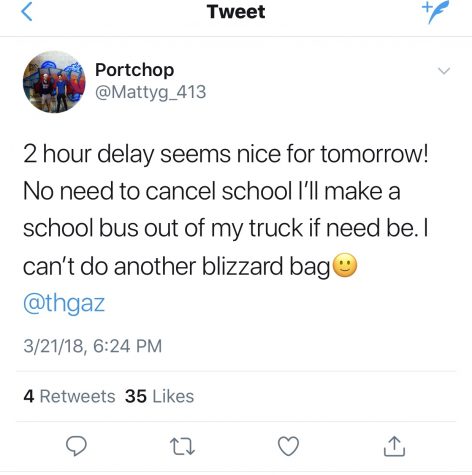Blizzard bags burden students

April 11, 2018
On winter mornings when a blanket of snow covers the ground and an early phone call cancels school, most students are thrilled. It’s an opportunity to sleep in past 5 or 6 AM and allows students to get ahead on work or simply take a break. However, blizzard bag days were implemented this year and many students are unhappy with the extra workload.
“Blizzard bags” are assignments from each class given on snow days. Rather than extending the school year because of the day off, the blizzard bags completed at home count as a regular day of school. Students are given five days to complete the work.
As spring begins to warm up the temperature and the likelihood of another snow storm diminishes, the efficacy of blizzard bags is up for debate. Although summer vacation may start a few days earlier, is the stress and disruption of blizzard bags really worth it?
Blizzard bags help the district meet the required 180 days of school, but they hinder students’ educations. The mere paper assignment does not equate to what students accomplish in a classroom: participating in face-to-face discussions, asking questions, and completing various activities. This is especially true for students in special education programs who require additional assistance.
Classes also face disruptions as they review the contents of the blizzard bags, rather than resume the curriculum from before the snow day. Because the assignments must be given ahead of time, they rarely align with the teachers’ current lesson plans. Although the day off in a snow day may have seemed to disturb learning, they actually only paused it; blizzard bags, however, insert new material and cause a disruption.
Rather than helping blizzard bags overburden and cause stress among many. Even before blizzard bags, most classes had work students could complete on snow days, such as studying for an upcoming test, completing a reading assignment, working on an essay, or reviewing old concepts. Now students are stripped of the time to accomplish these tasks, and are forced to complete new assignments.
Students must complete an assignment for all of their classes and the workload is often burdensome. Some teachers grade the blizzard bags as a quiz or for correctness, so the work takes extra time and effort. For students with jobs, college applications, scholarships, and other homework to work on, the blizzard bags are tedious and time consuming.
Additionally, some students choose to completely ignore the blizzard bags. This only results in a zero on the assignment and uses one of the 18 absences allotted to each student. These consequences don’t seem grave to a lot of students, but their educations may be at a disadvantage.
Blizzard bags don’t occur in a structured learning environment and cause equity issues. Some students may not have internet access or may have varying levels of assistance at home. Although the concept of preventing snow storms from extending the school year is beneficial, the actual implementation of blizzard bags causes more problems than it solves.
The next time a layer of snow coats the streets, I hope Superintendent Todd Gazda reconsiders letting students hit snooze on their alarm rather than burying them in extra assignments, readings, and essays.
Students share their opinions about blizzard bags with Superintendent Todd Gazda on Twitter.






